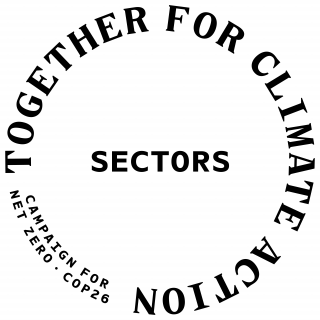Using scenarios for future diets and food production under climate change
26 October 2021
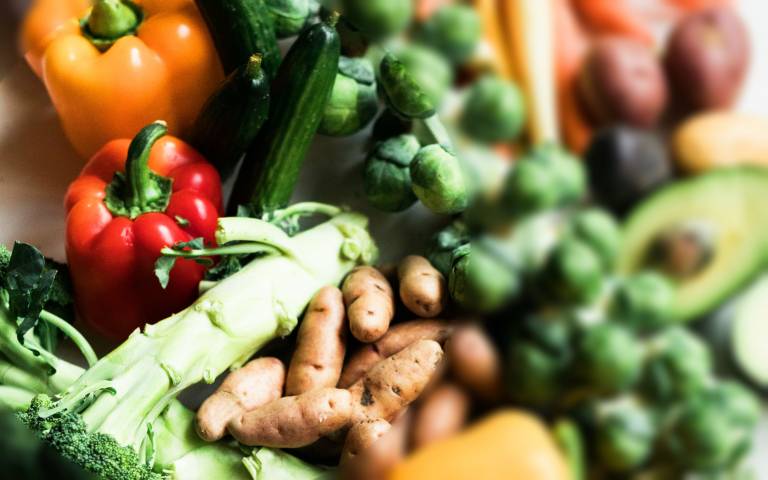
What are ‘scenarios’ scientists use when thinking about what might happen in the future with climate change?
Thanks to Covid-19, we have all become used to seeing graphs illustrating recent trends in a given phenomenon and showing how scientists expect such trends to develop in the future, under different scenarios. Scenarios are widely used when projecting the potential impacts of different future trends, including for climate change and decarbonisation.
The Intergovernmental Panel on Climate Change sometimes call their scenarios ‘pathways’, one of which is ‘business-as-usual’: this scenario assumes that we, industries, and governments, will continue doing what we are already doing into the future. They also present alternative pathways or scenarios (see image below) for very different trends in greenhouse-gas emissions and the impacts they have - both improved (e.g. low emissions pathway, below) and worsened (e.g. highest emissions scenario, below) compared to business-as-usual.
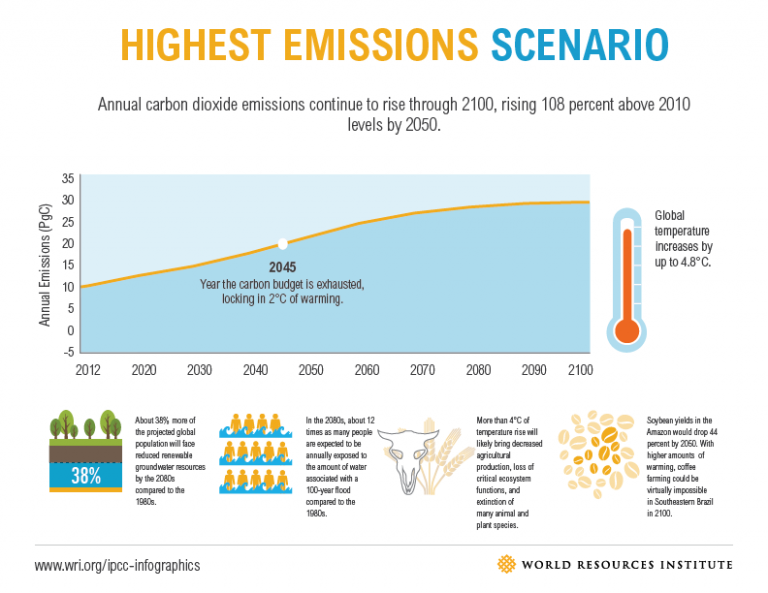
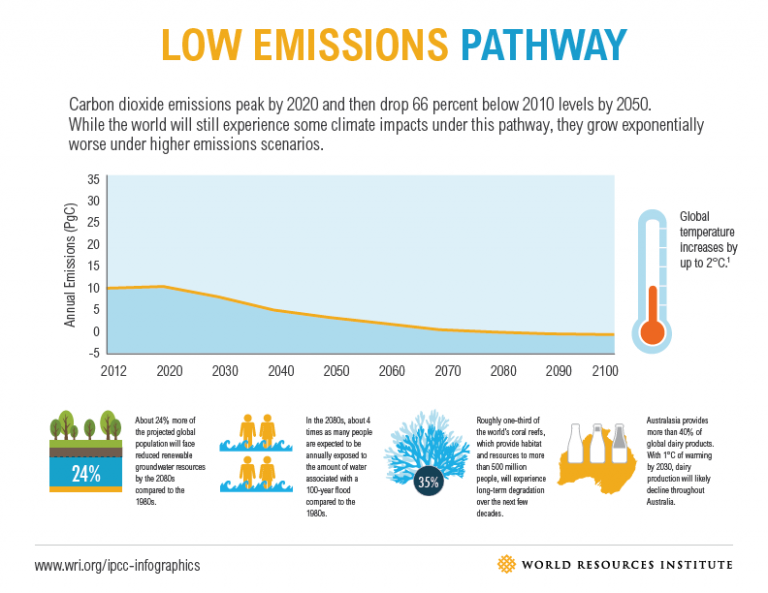
Examples of the scenarios and assumptions used by the Intergovernmental Panel on Climate Change. Note that the words ‘scenario’ and ‘pathway’ are used interchangeably. View the high resolution diagrams on the WRI website.
Scenarios tend to be made up of storylines, covering different aspects of society. In relation to food security, for example, this may include how much food we each eat, what sort of food, and where we get it from, and the amount and speed at which these things change over time. Each part of the storyline is an educated guess, or an ‘assumption’, based on what we know of past and present human and environmental processes. To continue the food-system example, if people in some parts of the world currently eat too much on average, especially of sugary processed foods imported from abroad, a storyline that sees these trends continued into the future would be considered ‘business-as-usual’, with ‘too much’, ‘sugary processed’ and ‘from abroad’ key assumptions that define this storyline. Each part of the story in a scenario can be mapped, measured, and modelled, so we can see what happens in the future regarding different metrics of interest as these assumptions interact.
Why are scenarios useful in helping us to think about the future, and how can they help us decide what we do today?
Based on our understanding of the history of the planet, we know that it can be a lot warmer, or a lot cooler, than it is today. However, we humans haven’t been on the planet for very much of Earth’s history, and, since the Industrial revolution in particular, we have had a huge impact on the planet’s climate. We are likely to continue to do so long into the future too, as the climate is influenced by the emissions we have already produced.
Scenarios help us to explore alternative futures for the planet and society, based on choices around the activities people engage in - from farming and mining, to driving and heating our homes - to find the most sustainable ones. We can test various changes to human activities and look at the future impacts of these changes. If there are outcomes we don’t like, we could decide to stop engaging in the activities that produce them. For outcomes that seem quite beneficial, we might want to encourage people to engage more in the activities that drive them. In turn, we can also test what might happen to human activities if changes in planetary systems, such as the climate, occur over time.
- We can’t be 100% certain about the impacts of future climate change as humans keep changing what they do (e.g., building new technology and expanding agriculture).
- To try and make decisions in an ever-changing world, scientists use scenarios to compare the outcomes of different decisions, or future ‘pathways’.
- Scenarios, like stories, also take the personal ‘edge’ off a complex issue. They enable scientists to generalise, so the people affected by or causing the problem can listen and communicate without feeling the need to be defensive of the current situation.
Scenarios are very helpful for testing out specific impacts of climate change. For instance, at UCL’s Institute for Sustainable Resources, researchers on the ‘Sustainable and Healthy Food Systems’ (SHEFS) project have been using scenarios to investigate what might happen to food production as the climate changes and what this means for growers, biodiversity, water supplies, and our diets and health in the future. They have compared different diets according to nutritional benefits and dependence on imports, for example (see image below).
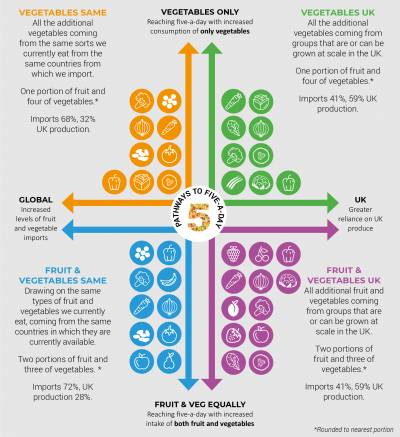
Example of scenarios being used to explore changes to UK diets and dependence on imports from the Sustainable and Healthy Food Systems (SHEFS) project. Find out more about this and view the high resolution diagram.

Example: Using scenarios to investigate the water sustainability of crop production in South Africa
Dr Sara Bonetti, as part of the SHEFS project, has been using climate change scenarios (called RCPs, Representative Concentration Pathways) to assess the sustainability of crop production in South Africa, under current conditions and alternative future climates. South Africa is a water-scarce country and climate projections suggest an increase in drought events over the next century, with implications for food security, especially in rural communities. Furthermore, as one of the UK’s trading partners, the impacts of climate change on water resources to grow food in South Africa has potential knock-on effects for the availability of food in the UK too. In this work, Sara and her colleagues mapped the spatial distribution of water consumption to grow major food crops in South Africa and assessed their sustainability. The investigation of climate-change scenarios showed that existing pressure on water resources is expected to increase, especially under the ‘worst case’ scenario with strongest climate change. The team identified crop types, such as wheat, and locations where production is likely to become more (or less) sustainable under future climates. It is through the analysis of possible future scenarios that pathways for optimal land use planning and management strategies can be devised to reduce current and future pressures on water resources and inform ongoing discussions on land reform.
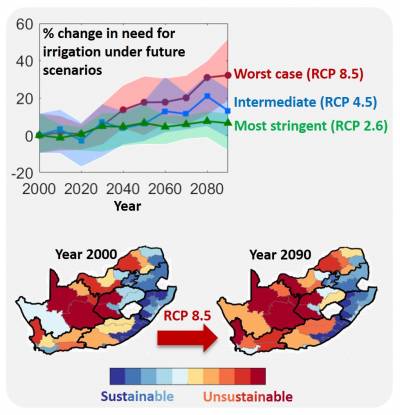 Modelled projected changes in South African crop water requirements under future climate scenarios (top panel) and predicted changes in district-level crop water sustainability under the worst-case scenario RCP 8.5 (bottom maps). Source: Bonetti et al., in prep.
Modelled projected changes in South African crop water requirements under future climate scenarios (top panel) and predicted changes in district-level crop water sustainability under the worst-case scenario RCP 8.5 (bottom maps). Source: Bonetti et al., in prep.

Ok, so scenarios sound useful, but who designs them? If scientists design scenarios, how can they be sure they are capturing the real experiences of people living in the country being studied?
Scientists can develop scenarios using their expert opinion, based on years of fieldwork, data collection, and reports. However, more recently, scientists have emphasized the importance of involving local people affected by the issue being investigated - stakeholders - in scenario design. Whilst the aim of scenarios is to examine the effects of different future ‘storylines’, not necessarily reflecting what we hope will happen, designing scenarios with stakeholders ensures that socioeconomic, political, cultural, and other factors can be incorporated into the scenario assumptions.
Example: Designing scenarios with stakeholders in Ghana
Dr Abbie Chapman visited Ghana with colleagues on the ‘Social and Environmental Trade-Offs in African Agriculture’ (Sentinel) project to participate in a stakeholder workshop to develop future scenarios for agricultural development in Ghana. The stakeholders - representing government ministries, civil society, and non-governmental organizations - expressed concerns about the impacts of climate change on Ghanaian farmers and the future of agriculture. It was only through working together to build scenarios for Abbie and colleagues to map and model at UCL, in collaboration institutions across the UK and Africa, that we could explore different drivers of agricultural development in Ghana, the impacts on people and the environment, and how these might be affected by decisions on future land use.
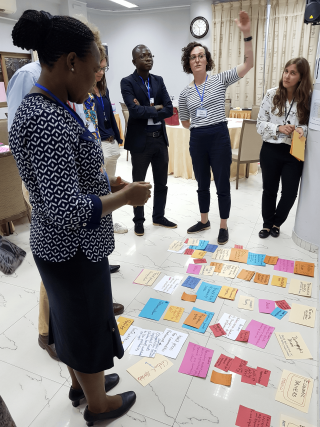 Stakeholder workshop, Ghana (credit: Sentinel project)
Stakeholder workshop, Ghana (credit: Sentinel project)

Further reading
More information on the SHEFS project can be found here: https://shefsglobal.lshtm.ac.uk/
More information on scenario building work in Ghana, Ethiopia, and Zambia for the Sentinel project can be found in project blog posts here: https://www.sentinel-gcrf.org/blogs
 Close
Close


